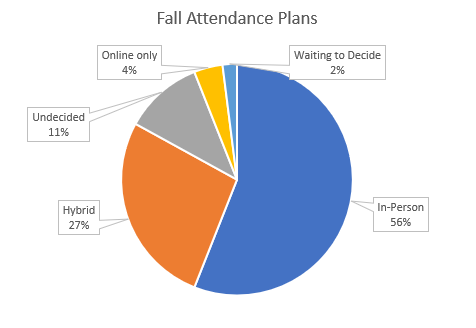As July comes to an end, colleges and universities are still struggling to come to grips with how to pivot dining options and policies to best address the pandemic. While many institutions have announced fall attendance plans, it appears that specifics on student meal plans are still forming themselves to best fit the needs of a changing environment.
To get some perspective and insight into the decision-making process, we surveyed 55 schools across the United States in June/July: large and small, public and private, from California to New York.
To see how our early findings compare to the latest industry reports, click here to view the Chronicle of Higher Education’s list of announced college plans.
Here’s what we learned about college and university decision-making for Fall 2020:
Fall Attendance Plans
Attendance plans for the fall were generally optimistic, with 56% of campuses planning for in-person classes, followed by 27% opting for a hybrid approach, with a mere 4% planning for online-only.
Meal Plan Changes
For most institutions (55%), there were no changes being considered for the fall semester, with just under a third actively planning for changes.
Some Takeaways
At the time of interview, over half of the schools we surveyed were planning on picking back up where they left off pre-COVID, with regular in-person classes and no change in meal plans.
Almost 30% of those surveyed had already made changes to the fall meal plan offerings, whether in the number of meal plan options, amount of flex or dining dollars, or in the price of the meal plan itself.
However, as might be expected, the number of programs considering a range of scenarios or waiting to see how the pandemic would progress was much higher in May than in July.
Some interesting examples of how colleges and universities were reacting:
University A will mark the end of the fall semester at Thanksgiving break, having students finish all work and exams remotely. Given this change, required meal plans have been discounted to reflect the students’ early departure from campus and changes made in the dining options to respond to the COVID-19 pandemic.
University B’s unlimited plan has been replaced with 19+ at the same price which would restrict the number of times the students can enter the dining hall.
Most Common Protocols Discussed
The following changes, many of which are now accepted as industry-standard, were being explored as novel solutions very early in the process.
Limiting “regular” options and moving towards a to-go centric model.
Suspending commuter plans entirely
Limit dining space capacity to 50% or less
Allow guests to collect multiple meals at a time
Utilizing single-use containers for grab-and-go
Fast-tracking the integration of mobile and contactless ordering and delivery
Open and overt cleaning, sanitizing and disinfecting processes
Required face masks
Converting self-serve salad bars to service stations
Conclusions
With the exception of an increased adoption of online-only semesters, it looks like our limited slice of the industry turned out to be fairly representative of the whole, even in the longer-term. From that perspective, it seems that most campuses will be sticking with their current meal plans and integrating in local and regional COVID-19 mandates such as masks or physical distancing.


